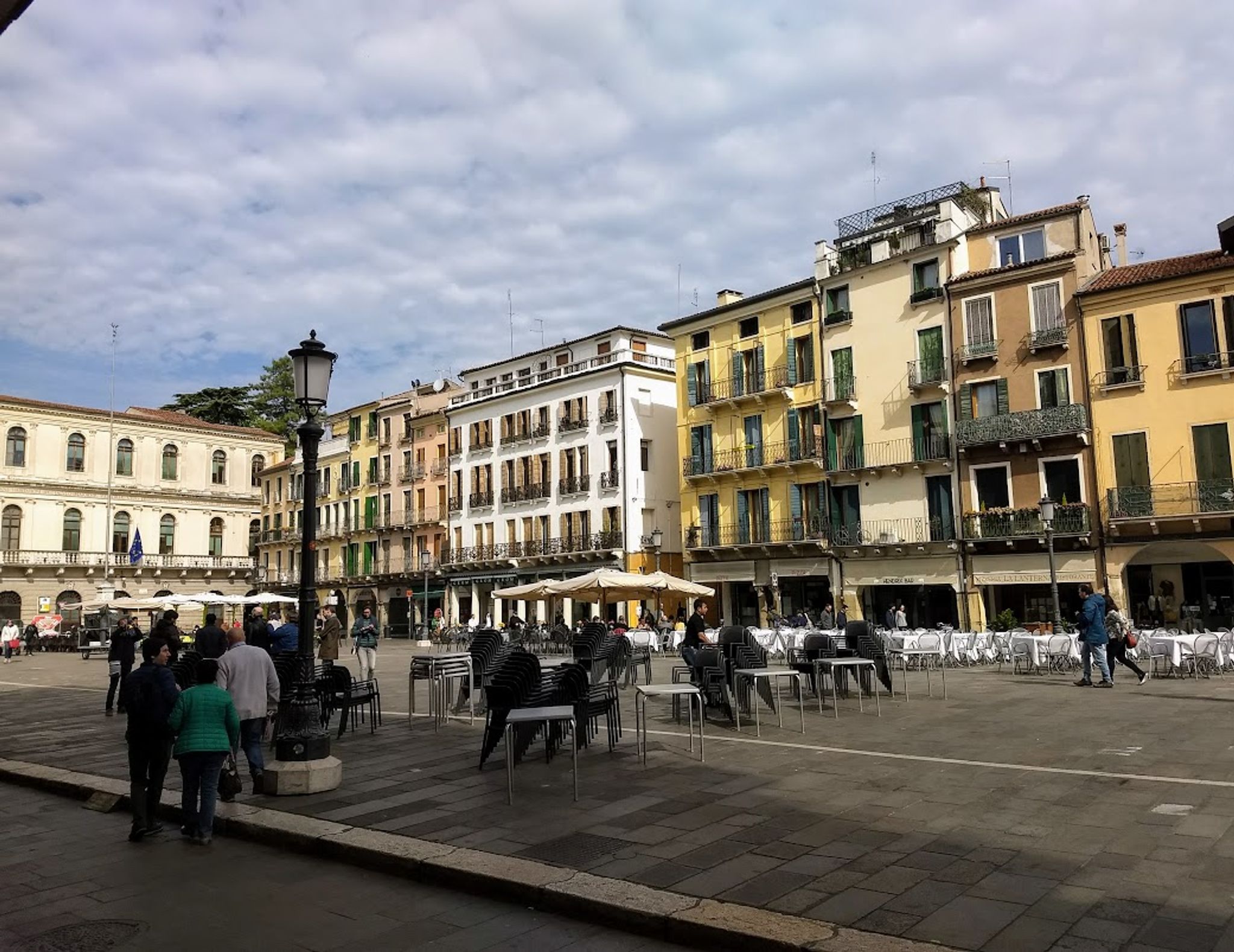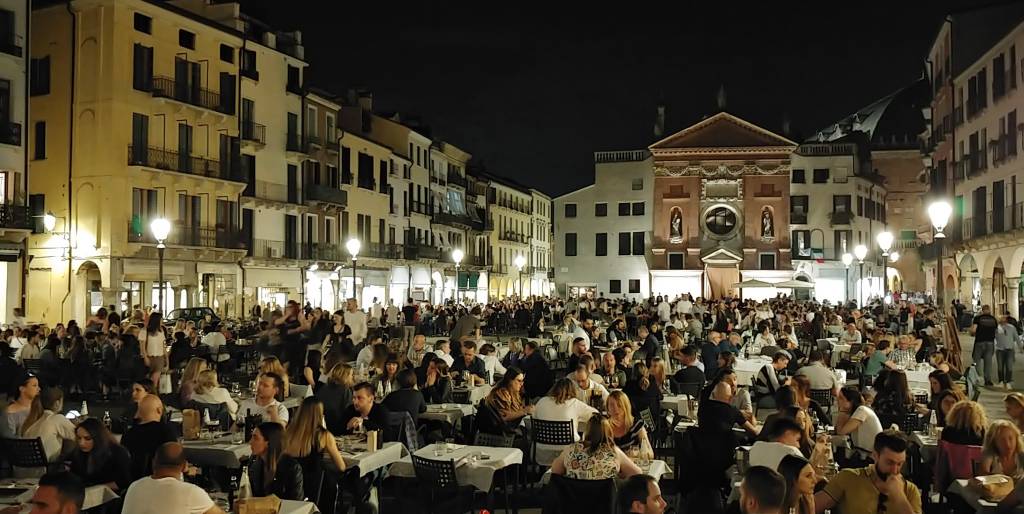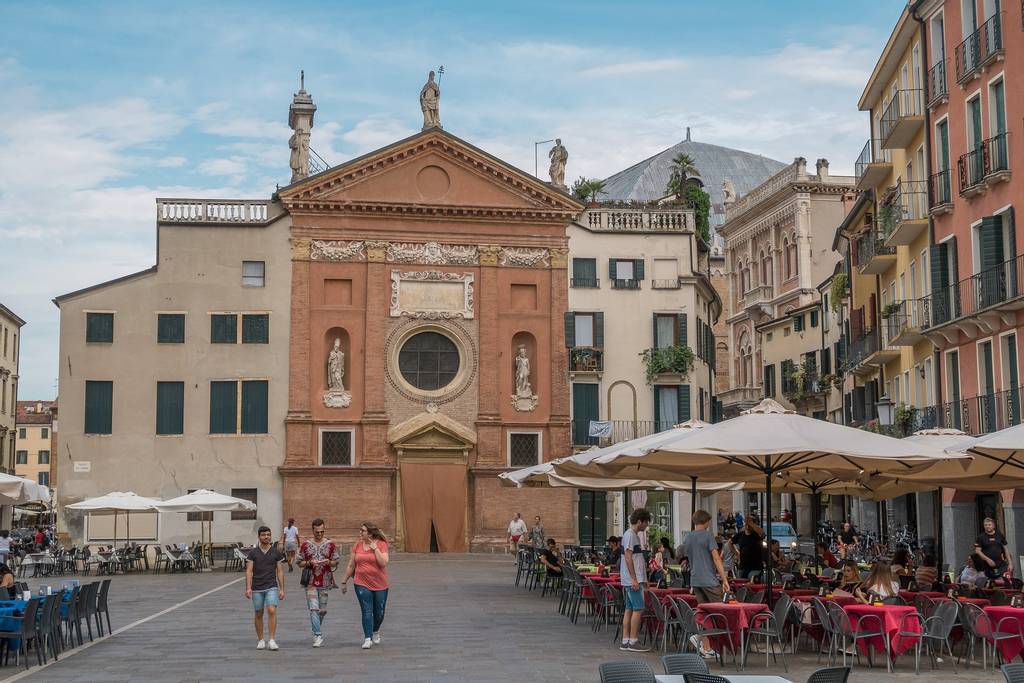Piazza dei Signori
Piazza dei Signori is an elegant open square surrounded by monumental works, fulfilling the role of the grand living room of Padua.

Piazza dei Signori is an elegant space located in the city’s core, nestled between Piazza Capitaniato, Piazza Duomo, Piazza delle Erbe and Piazza della Frutta. While the last two larger squares were for centuries accommodating commerce and festive public celebrations, Piazza dei Signori is the place which served as a representative space for the city, a venue for jousting and tournaments, and civic and government celebrations. The name dates back to the era of the Carraresi, whose Royal Palace overlooked the square.
The rectangular square is paved with Euganean trachyte slabs, which replaced the original terracotta flooring arranged in a herringbone pattern. Similar to the other squares, Piazza dei Signori hosts a lively market every morning, where mainly clothing and other goods are sold. In the afternoon, it is transformed into an elegant lounge with the tables of the bars and cafes, a trendy place, especially during the aperitif time.
The square is dominated by the profile of the famous Clock Tower, rising between two symmetrical buildings, the Palazzo del Capitanio and the Palazzo dei Camerlenghi, built between the sixteenth and seventeenth centuries, in place of the Carrara Palace.
The palace on the left of the tower is Palazzo del Capitanio, the seat of the Venetian government authority in Padua during the period of the Serenissima. The tower incorporates the famous astronomical clock built in 1428 on a design by Jacopo Dondi. The triumphal arch at the base of the tower is the work of Giovanni Maria Falconetto, and it’s the passageway connecting Piazza dei Signori to Piazza Capitaniato.
In front of the Palazzo del Capitanio, there is a Roman column crowned by a Lion of Saint Mark, the symbol of the Serenissima. The one standing today is regrettably a copy, sculpted in 1870 by Natale Sanavio to replace the original, which was demolished in 1797 by Napoleon's troops after the fall of the Venetian Republic. On the right side is a sixteenth-century flagpole, resting on a base in Istrian stone and a marble pedestal with the Cardinal Virtues carved in high relief on the sides.
Colourful Venetian buildings surround the square on the other three sides, accoutered with arcades and enriched by splendid terraces and ancient wrought-iron balconies. The splendid Loggia del Consiglio stands in the southwest corner. Next to the Loggia are the curious and very narrow Casa del Boia and Palazzo Foscari, both rebuilt after being hit by a bomb during the Second World War.
The east side of Piazza dei Signori houses the ancient Church of San Clemente, flanked by the two streets, Via San Clemente and Via Fiume, leading to Piazza della Frutta and Piazza delle Erbe, respectively.
Church of San Clemente
The small Church of Saint Clement is a medieval building dating back to 1190. The church is attached on three sides to the adjacent buildings.
The terracotta facade is defined by four large pilasters with a large rose window in the centre above the entrance. On the sides, two niches house the statues of Saint Eligio on the left and Saint John the Baptist on the right. Above the large tympanum are the seventeenth-century statues of Saint Clement, Saint Justine and Saint Daniel.
The simple interior is structured in a single nave with a square apse. Next to the entrance is the Madonna and Child fresco by Jacopo Bellini, one of the founders of the Renaissance style of painting in northern Italy and the father-in-law of Andrea Mantegna. On the right wall is a seventeenth-century painting by Pietro Damini depicting Jesus in the act of delivering the keys to Saint Peter.
Loggia del Consiglio
The Council Loggia, also called Loggia of Gran Guardia, is an elegant building built on a 1496 project by Annibale Maggi da Bassano to accommodate the city council following the fire that damaged the Palazzo della Ragione in 1420. It was finished in 1553 by Giovanni Maria Falconetto, an Italian architect who designed two of the first high Renaissance buildings in Padua, the Loggia and Odeo Cornaro.
The elegant and delicate facade is made of polychrome marble with three mullioned windows on the upper floor. A wide staircase leads into the ground floor portico formed by seven arches supported on columns and pillars with a beamed ceiling richly decorated with coats of arms.
The great council chamber is embellished with a coffered ceiling and a series of frescoes, painted by Pier Antonio Torri in 1667. On the east wall, a canvas depicting Padua between Justice and Wisdom, a replica by an uncertain author, which replaces the original painting made by Domenico Campagnola in 1537 and now preserved in the Eremitani Civic Museums.
We welcome all contributions, no matter how small. Even a spelling correction is greatly appreciated.
All submissions are reviewed before being published.
Continue to changelog-

© 'Piazza dei signori di Padova' by Camelia.boban is licensed under CC BY-SA 4.0 Attribution copied to clipboard Failed copying attribution to clipboard -

© 'Piazza dei Signori, Padova' by Guerinf is licensed under CC BY-SA 4.0 Attribution copied to clipboard Failed copying attribution to clipboard -

© 'Piazza dei Signori with Chiesa di San Clemente' by Gerhard Bögner Attribution copied to clipboard Failed copying attribution to clipboard -

We welcome all contributions.
All submissions are reviewed before being published.
We welcome all contributions, no matter how small. Even a spelling correction is greatly appreciated.
All submissions are reviewed before being published.
Continue to changelogPiazza dei Signori
We welcome all contributions, no matter how small. Even a spelling correction is greatly appreciated.
All submissions are reviewed before being published.
Continue to changelogWe welcome all contributions, no matter how small. Even a spelling correction is greatly appreciated.
All submissions are reviewed before being published.
Continue to changelogCategory
Cost
-
44 m
One of the beautiful Venetian buildings surrounding the square of Piazza dei Signori is Loggia del Consiglio, an outstanding example of the architecture of the 15th and 16th centuries.
-
Torre dell'Orologio is a medieval clock tower which rises between the Piazza del Capitaniato and Piazza dei Signori, representing one of the symbols of the Carrarese era in Padua.
-
The Church of San Clemente is a small Baroque-style Roman Catholic church with an ancient history overlooking the Piazza dei Signori.
-
145 m
A true miracle of architectural audacity and an impressive collection of fourteenth-century mural paintings, the only secular and civil commission executed by Giotto in Padua
-
The Palazzo della Ragione, built in the Middle Ages as the seat of the city courts, still hosts on the ground floor one of the oldest European markets




